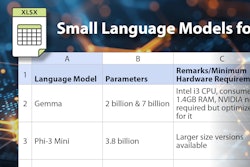
Encoders are a key component of motion control systems in that they send a feedback signal to the controller to determine factors such as position, count, speed, and direction. The most common terms used to describe the capabilities of an encoder are resolution, accuracy, and precision.
What makes the use of these terms confusing is that they are often used interchangeably. If an encoder has high resolution, doesn’t that mean it’s accurate? And if it’s accurate, then it has to be precise, right?
The reality is that these terms are independent of each other, with each referring to specific encoder characteristics that are not interchangeable.
To get a better understanding of this, we connected with Neal Donowitz, COO of US Digital, a supplier of absolute and incremental encoders.
Resolution
“When applied to optical encoders, resolution specifies the number of times the output signal goes high per revolution,” said Donowitz. “This number can match the number of lines on a disk or, especially with higher resolutions, it can be a multiple of the number of lines.”
The lines Donowitz refers to are a physical reality (i.e. the physical lines on a physical disk used by an encoder — see image). The number of lines on a disk denote the disk’s resolution. Typical values range from low numbers like 32 or 64 to much higher resolutions of 5,000 or 10,000 and beyond.
“However, a motion controller can interpret the output waveforms resulting from those lines and produce higher resolutions—from the same disk,” said Donowitz. This is possible with incremental encoders via quadrature, in which an additional LED and photosensor are added to the encoder, enabling the resolution of an encoder to be multiplied by a factor of two or four as compared to the resolution indicated by the physical lines on the encoder’s disk.
It’s important to note that resolution issues discussed thus far relate to incremental optical encoders. Absolute encoders operate differently, Donowitz said. “They output a unique code for each position on the disk—each code is absolute, which means it is unlike any other code on the disk. It specifies a unique, absolute position on the disk. Resolution for absolute encoders is defined as the number of positions per revolution as the disk rotates through 360 degrees.”
Absolute encoders don’t use quadrature, so there is no equivalent to resolution multiplication that’s available with incremental encoders. However, an absolute encoder with a bar code can offer programmable resolution. For example, a 12-bit encoder (4,096 positions per resolution) can be programmed to output from two to 4,096 codes per revolution.
Accuracy
The difference between target position and actual position defines an encoder’s accuracy. “In an ideal world, they would be the same. But in the real world, there are variations,” said Donowitz. “The actual position—where the encoder really is—might be off from the target position by a small amount, as indicated by the range in the encoder’s accuracy specification.”
For rotary encoders, accuracy is measured in degrees, arcminutes, or arcseconds. Which units are used depends upon the encoder being measured. Degrees might be sufficient for a low accuracy encoder; fractions of a degree or arcminutes are suitable for encoders with medium accuracy; while arcseconds might be used for ultra-high accuracy encoders.
Because encoders are typically part of a larger motion control system, the non-encoder parts of that system can have a dramatic impact on overall system accuracy, noted Donowitz. “Encoder manufacturers control some of the factors that affect accuracy, but end users control application-specific factors.”
To explain the differences in encoder accuracy, Donowitz suggested an example of a manufacturer offering two versions of a magnetic absolute encoder—one with 12-bit resolution and the other with 10-bit resolution. The encoder’s data sheet notes that, while the accuracy is the same for both encoders, the 12-bit version provides higher resolution.
“The accuracy of the two encoders is the same,” said Donowitz. “Therefore, this example shows that accuracy and resolution are not related to each other. Accuracy describes target position versus actual position. Resolution describes how finely a disk is divided. These are independent properties. If a machine designer needs an encoder that can report positions every tenth of a degree, then the designer needs more resolution, not more accuracy—and the 12-bit encoder would be a good choice.”
Precision
Having explained the difference between resolution and accuracy, Donowitz said the concept of precision applies to every component of a motion control system, not just the encoder. "For example, consider a cut-to-length application where an encoder is attached to a motor that drives a ball screw and actuator that positions wire for cutting. Now suppose the system is set to cut the wire at exactly 12.00 inches. After the first four wires are cut, they are measured with the following results: 11.81 inches, 11.82 inches, 11.80 inches, and 11.81 inches.”
Because the difference between readings is small, Donowitz said this would indicate that the system has good precision and that the error could be coming from nearly any component in the system—the encoder, the motor, play in the threads of the ball screw, or in the bearings of the linear slide.
To correct for this error, Donowitz said the differences in wire length can be used to calibrate the application. “For example, you can add 0.20 inches to the final target position of 12.00 inches to end up at a compensated position of 12.20 inches. When the wires are then cut, they will be very close to the desired length of 12.00 inches.”
“Precision, then, is the amount that successive measurements differ from each other,” explained Donowitz. “An encoder that has position errors which are repeatable may have good precision, even though it may not be perfectly accurate. In this case, the precision can be used to compensate for the inaccuracy of the encoder.”
Based on the explanations provided by Donowitz it’s easier to see why the terms resolution, accuracy, and precision are independent of each other. To recap: Resolution refers to the number of cycles per revolution or cycles per inch of an encoder; accuracy is the difference between target position and actual reported position; and precision is the difference between repeated measurements.
“Understanding resolution, accuracy, and precision will help you make decisions when you choose an encoder,” said Donowitz.
To access a US Digital white paper explaining the differences between encoder resolution, accuracy, and precision in much greater detail, visit: https://cdn.usdigital.com/assets/general/usd-encoder-precision.pdf.

















